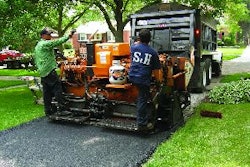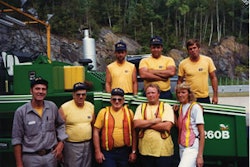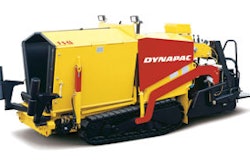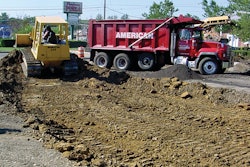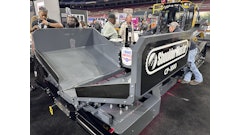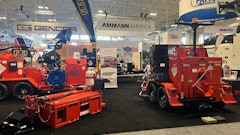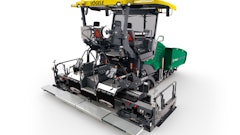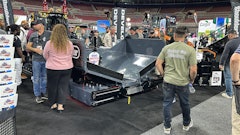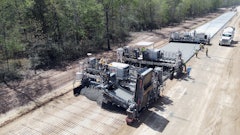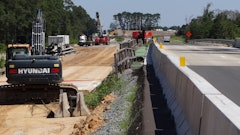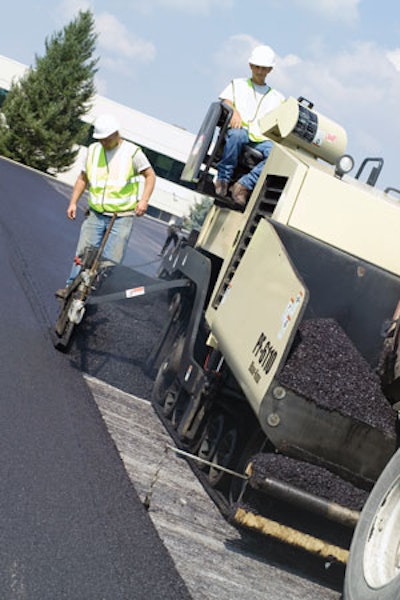
Admittedly, few jobs are completed "in a perfect world," but that doesn't mean we shouldn't be striving for that goal. Most people think the foreman controls the job, and from a broad company-wide standpoint that is the case. But it's the paver operator who controls the paving operation. He is responsible for keeping the paving operation moving, which is why I call him (or her) "the time clock."
That's not to say the paver operator is in it all alone; he's not. He's in constant communication with the screed operator, communication made easier and easier these days with the help of a variety of technologies. But once the job has started it is the paver operator's responsibility to keep it moving and moving at the right pace.
So, what kind of background does a paver operator need? First of all, he needs to understand the entire paving operation, from what happens when the crew arrives at the site to what happens when they leave. He needs to understand all the demands of each particular job and where his work fits in with those requirements.
He needs to know the paver he's working with inside and out, including how it feels when it's working properly, what each of the components can and can't do, how the components work together, and how the speed of the paver affects what each component does. And he needs to recognize that while his job is maintaining the pace and continuity of the paving job, the screed operator is tasked with managing yield, mat thickness, and overall mat quality. Through his communication with the screed operator the paver operator becomes a partner in making sure a quality job is completed on time and within budget.
Keeping the pace
The pace at which a paver moves has an impact on the mat, in thickness for example, and in compaction from the screed. The speed of the paver affects the head of material (the flow of material coming into the screed) and if the paver speeds up the screed will drop (as the head of material falls); if the paver slows down the screed rises (as the head of material increases). So speed is critical and it needs to be as consistent as possible.
Just as the screed operator keeps the job on track and on budget by controlling the yield, the paver operator keeps the job on track and on budget by controlling the pace of the work. How he does this starts with his pre-job meeting each morning when he meets with the foreman and the screed operator to learn how the job is going to progress. The three walk the job, determining where the job is going to start, where it's going to end, how wide the passes are going to be, and how they are going to handle islands, light poles, manholes, catch basins, and other obstacles.
So for each job the paver operator needs to know how much time the job is scheduled for (Do we have a six-hour window? An eight-hour window? Is this job planned to go over two days?) He needs to know the thickness of the mat, the total tonnage of each pass, the total tonnage to be placed on the job, the tonnage of mix carried by each haul truck, and how far the plant is from the jobsite. All these factors have an impact on how he approaches the actual paving, especially how fast he paves.
When the paver operator learns from the foreman how many tons per hour he will receive from the plant, and how many trucks that will mean, he can figure out how fast he will be able to pave to keep the entire paving operation going so the crew isn't standing around. If he can keep the operation going he can keep the truck fleet moving. And if he can catch the trucks as they come and go he will be utilizing the trucking service as efficiently and cost effectively as possible.
Pave in a straight line
Being able to drive a paver in a straight line is also an essential skill for the paver operator. Gone are the days when the operator could follow the edge of the pavement, the lawn, or a line of tack. This is especially true of parking lot paving where the shape of the pavement is almost always irregular and because the customer wants the job to look perfect.
The crew needs to put a line down and the operator has to follow that line - especially on the first pass. If the first pass is crooked or even slightly off, that discrepancy is compounded as the job progresses and each pass will be more crooked than the last, leading to a fix-up pass at the end that won't look very good.
To make sure he paves straight he needs to rely on the guide bar, the rod on the front of the paver that enables him to track the edge he wants to follow. In some cases the rod has a chain that hangs straight down making it even easier to follow the line. Now, some operators can use the edge of the hopper to follow the line, and if you're an experienced paver you might be able to do that effectively on a 10-foot paver or smaller. But once you get over 10 feet it's very difficult to maintain that edge.
In some cases after that first pass an experienced operator can follow that edge to stay straight. But, especially in parking lot paving, it's important to measure and mark out each pass because of islands, light poles, and other obstacles that might require uneven passes. You might start with 10 feet and then go to 12 and then back to 10. It's very easy to make a mistake paving the wrong width in those situations if you don't have them marked out.
Additional essential tips
Understand - and use - the instrument panel. There's no one to tell him how to keep the operation moving, so he must rely on the gauges surrounding his perch on the top of the paver, and it's his responsibility to be fluent in what those gauges are telling him.
A foot-per-minute gauge is essential, and if your paver isn't equipped with one you can buy one and add it on yourself (though most pavers 8 feet and larger come equipped with them). With an fpm gauge the paver operator doesn't have to concern himself with paving too fast or too slow - just follow the gauge. In addition every paver must have a fuel gauge, and this gauge must be checked each morning and then eyed constantly throughout the day. It can often take 30 minutes or more to get a fuel truck to a jobsite, and if the paver has to shut down while waiting for that truck, not only is labor unproductive and costly, the haul trucks are lining up at the jobsite and soon you're way behind and losing money.
It goes without saying that all the gauges should be in proper working order - they improve quality and efficiency and even profitability of the finished job, but too often broken gauges are left broken - it's the paver operator's job to make sure they are repaired promptly. And that's a responsibility he should relish because those gauges can make his job easier.
Use your horn! Horns on pavers seem to be broken more often than any other part of the equipment. Amazingly, no one seems to think horns are critical, yet horns are such an important part of the equipment that paver operators - and foreman and company owners - should insist they be operating all the time. Why? Because a human being can only yell so loud, but regardless of whatever is happening on the jobsite the horn will cut right through it and get everyone's attention. That horn should be able to work at all times; it's a safety issue. In fact, at some companies if the operator beeps the horn, all activity stops.
Teach everyone to turn off the paver. Every operator at one time or another steps off the machine while leaving it running. A simple step that could save lives and protect from property damage is to take a few minutes to teach everyone on your paving crew how to shut the paver off.
Are you a paver operator?
The best paver operators often are detail-oriented. They are smart, they understand the entire paving operation, and they understand the paver itself - how each component works and what happens with the paver as it speeds up or slows down.
Paver operators generally want to know everything that's going on, they usually want to know why it's going on, and they don't like hearing "I don't know" for an answer. Because when he's up on the paver, placing an overlay at 20 feet per minute, that "I don't know" answer is going to result in some type of problem for the paving crew or the contractor - whether it's a delay (a waste of money) or poor quality work that must be fixed (delay, wasted time, wasted money).
So paver operators often are the most self-confident people on the crew - they have to be because they are making quick decisions on the fly, adapting to what's happening during the day, and they don't have the time to second-guess themselves.
Paver operators must be alert and constantly aware of everything that is going on around them. Paver operators are situated in the highest spot on a paving job so they have the best view of virtually the entire operation. Every other person on the crew is at or near ground level and can't see over the big paver, so the operator must assume responsibility of policing the jobsite. He needs to know where the laborers are, where the rollers are, and where the trucks are coming in from and going out from. He needs to be aware of traffic concerns surrounding the jobsite and needs to keep an eye out for pedestrians.
So paver operators, who usually move into that job from screed operators are, in the best sense of the term, "know it alls," and if your crew has a good one you should consider yourself fortunate; if you are not a paver operator and want to be one, polishing the skills discussed here will help you on your way.
For more on the role of a paver operator see the online featured article "How Every Paver Operator Should Start and End His Day".
John S. Ball III, president of Top-Quality Paving, is a regular contributor to Pavement and an annual presenter on paving-related topics at National pavement Expo and National Pavement Expo West. Reach him at [email protected].




![Lee Boy Facility 2025 17 Use[16]](https://img.forconstructionpros.com/mindful/acbm/workspaces/default/uploads/2025/09/leeboy-facility-2025-17-use16.AbONDzEzbV.jpg?auto=format%2Ccompress&fit=crop&h=100&q=70&w=100)
